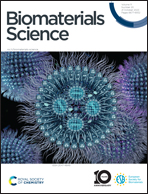Synergetic EGCG and coenzyme Q10 DSPC liposome nanoparticles protect against myocardial infarction†
Abstract
At the site of myocardial infarction (MI), various phenomena such as oxidative stress and myocardial apoptosis can be observed. Both epigallocatechin gallate (EGCG) and coenzyme Q10 (CoQ10) exhibit antioxidant and anti-inflammatory effects. Macrophages have demonstrated a higher internalization rate of cationic liposomes, thereby increasing their bioavailability. This study utilized EGCG in synergy with CoQ10 as an antioxidant agent and distearyl phosphatidylcholine (DSPC) as the carrier, to create liposome nanoparticles known as CE-LNPs. The CE-LNPs exhibited favorable biocompatibility and were effectively engulfed by macrophages in vitro. In addition, the CE-LNPs effectively eradicated reactive oxygen species (ROS) in hypoxic cardiomyocytes, mitigated myocardial cell apoptosis, and sustained the functionality and proliferation of myocardial cells. The anti-apoptotic effect of the CE-LNPs was further validated through TUNEL and Annexin V FITC/PI experiments. The therapeutic efficacy of CE-LNPs was evaluated in a murine model of MI. CE-LNPs demonstrated a significant reduction in scar area in vivo, facilitating cardiac repair and improving cardiac function. These findings provide evidence that EGCG synergistically combined with CoQ10 in DSPC liposome nanoparticles offers protection against MI.



 Please wait while we load your content...
Please wait while we load your content...